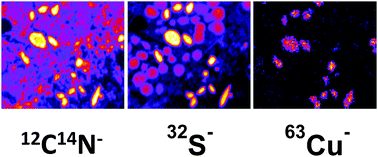当前位置:
X-MOL 学术
›
Metallomics
›
论文详情
Our official English website, www.x-mol.net, welcomes your feedback! (Note: you will need to create a separate account there.)
Transition metals and trace elements in the retinal pigment epithelium and choroid: correlative ultrastructural and chemical analysis by analytical electron microscopy and nano-secondary ion mass spectrometry†
Metallomics ( IF 3.4 ) Pub Date : 2017-12-14 00:00:00 , DOI: 10.1039/c7mt00259a Antje Biesemeier 1, 2, 3, 4 , Oliver Eibl 3, 4, 5, 6 , Santhana Eswara 7, 8, 9, 10, 11 , Jean-Nicolas Audinot 7, 8, 9, 10, 11 , Tom Wirtz 7, 8, 9, 10, 11 , Ulrich Schraermeyer 1, 2, 3, 4
Metallomics ( IF 3.4 ) Pub Date : 2017-12-14 00:00:00 , DOI: 10.1039/c7mt00259a Antje Biesemeier 1, 2, 3, 4 , Oliver Eibl 3, 4, 5, 6 , Santhana Eswara 7, 8, 9, 10, 11 , Jean-Nicolas Audinot 7, 8, 9, 10, 11 , Tom Wirtz 7, 8, 9, 10, 11 , Ulrich Schraermeyer 1, 2, 3, 4
Affiliation

|
Understanding the localisation and abundance of structural elements, trace elements and especially transition metals like Cu and Zn in ocular tissue sections is important for physiology, and also for the characterisation of diseases related to oxidative stress like age-related macular degeneration. Transition metal abundances were investigated in an aged donor eye by nano-secondary ion mass spectrometry (nano-SIMS) elemental mapping using Cs+ and O− primary ions, respectively, and correlated to their respective mole fractions investigated by analytical electron microscopy (AEM). The ultrastructure of the tissue and the elemental composition of melanosomes of the choroid and RPE, and RPE lipofuscin and melanolipofuscin granules can adequately be investigated by nano-SIMS using the secondary ion maps. Melanosomes, 0.5–1 μm in size, yield sulphur maps and maps of stored metals like calcium, sodium and copper. Lipofuscin shows especially high phosphorus signals. Elements with mole fractions of about 0.1 at%, e.g. for P and Cu, as investigated by AEM before, can be validated using simultaneous SIMS maps with an estimated lateral resolution of 66 nm with typical acquisition times of 30 minutes for each area of interest. However, Zn (0.19 at%) was not detected by SIMS. Nano-SIMS imaging of CN−, PO2−, S−, Cu−, Ca+, Fe+ and Na+ ions provides excellent detection limits demonstrating the possibilities for chemical mapping with high-sensitivity trace element detection and reduced acquisition times. Quantification of nano-SIMS data was achieved by correlating mole fractions obtained by AEM to secondary ions per pixel obtained by nano-SIMS. Both methods yield the melanin type in melanosomes and trace metal storage.
中文翻译:

视网膜色素上皮和脉络膜中的过渡金属和微量元素:通过分析电子显微镜和纳米二次离子质谱法进行的相关超微结构和化学分析†
了解眼部组织中结构元素,微量元素尤其是过渡金属(如Cu和Zn)的位置和含量,对于生理学以及表征与氧化应激有关的疾病(如与年龄有关的黄斑变性)具有重要意义。过渡金属丰度,通过使用铯纳米二次离子质谱法(纳米SIMS)元素映射在老化供体眼睛调查+和O -初级离子,并通过分析电子显微镜(AEM)研究其各自的摩尔分数。纳米SIMS可以通过二次离子图充分研究脉络膜和RPE,RPE脂褐素和黑素脂褐素颗粒的组织超微结构和黑素体的元素组成。尺寸为0.5–1μm的黑素体会生成硫图和诸如钙,钠和铜之类的存储金属图。脂褐素显示出特别高的磷信号。摩尔分数约为0.1 at%的元素,例如如先前由AEM进行的研究,可以使用同时SIMS图来验证P和Cu的Ps和Cu的横向分辨率,估计的每个感兴趣区域的横向捕获时间为30分钟,典型采集时间为30分钟。但是,SIMS未检测到Zn(0.19 at%)。CN的纳米SIMS成像-,PO 2 -,S - ,铜- ,钙+,铁+和Na +离子提供了出色的检测限,证明了通过高灵敏度的痕量元素检测和减少的采集时间进行化学作图的可能性。通过将AEM获得的摩尔分数与nano-SIMS获得的每个像素的次级离子相关联,可以实现nano-SIMS数据的定量。两种方法都会在黑素体中产生黑色素类型,并产生痕量金属。
更新日期:2017-12-14
中文翻译:

视网膜色素上皮和脉络膜中的过渡金属和微量元素:通过分析电子显微镜和纳米二次离子质谱法进行的相关超微结构和化学分析†
了解眼部组织中结构元素,微量元素尤其是过渡金属(如Cu和Zn)的位置和含量,对于生理学以及表征与氧化应激有关的疾病(如与年龄有关的黄斑变性)具有重要意义。过渡金属丰度,通过使用铯纳米二次离子质谱法(纳米SIMS)元素映射在老化供体眼睛调查+和O -初级离子,并通过分析电子显微镜(AEM)研究其各自的摩尔分数。纳米SIMS可以通过二次离子图充分研究脉络膜和RPE,RPE脂褐素和黑素脂褐素颗粒的组织超微结构和黑素体的元素组成。尺寸为0.5–1μm的黑素体会生成硫图和诸如钙,钠和铜之类的存储金属图。脂褐素显示出特别高的磷信号。摩尔分数约为0.1 at%的元素,例如如先前由AEM进行的研究,可以使用同时SIMS图来验证P和Cu的Ps和Cu的横向分辨率,估计的每个感兴趣区域的横向捕获时间为30分钟,典型采集时间为30分钟。但是,SIMS未检测到Zn(0.19 at%)。CN的纳米SIMS成像-,PO 2 -,S - ,铜- ,钙+,铁+和Na +离子提供了出色的检测限,证明了通过高灵敏度的痕量元素检测和减少的采集时间进行化学作图的可能性。通过将AEM获得的摩尔分数与nano-SIMS获得的每个像素的次级离子相关联,可以实现nano-SIMS数据的定量。两种方法都会在黑素体中产生黑色素类型,并产生痕量金属。



























 京公网安备 11010802027423号
京公网安备 11010802027423号